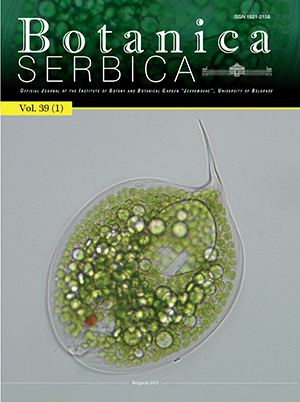
Volume 39 Issue 1 2015 |
Intra- and inter-isolate variation in two predominant
Plasmopara halstedii (sunflower downy mildew) races
in Europe
|
KEY WORDS: Plasmopara halstedii, sunflower downy mildew, EST-derived markers, morphology of zoosporangia and sporangiophores, aggressiveness, virulence, Helianthus annuus |
Compositional characteristics of the essential oil of
Pimpinella anisum and Foeniculum vulgare grown in
Serbia
|
KEY WORDS: aniseed, fennel, trans-anethole, methyl chavicol |
UV-B induced changes in pea (Pisum sativum)
pigments and antioxidative system: Effects of different
UV dose distribution on immature and mature leaves
|
KEY WORDS: pea, UV-B, dose distribution, photosynthetic pigments, antioxidative system |
Diversity of the Euglenophyta division in the Zasavica
River, Serbia
|
KEY WORDS: Euglenophyta, Zasavica, Serbia |
Oreopteris limbosperma (Bellardi ex All.) J. Holub,
rediscovered for the flora of Serbia
|
KEY WORDS: chorology, pteridology, Special Nature Reserve “Paljevine” |
New records and rare taxa of the genus Eunotia
Ehrenberg (Bacillariophyceae) for the diatom flora of
Serbia
|
KEY WORDS: Eunotia, diatoms, distribution, Dojkinci River, autecology |
Lectotypification of Linnaean names in Tussilago
(Asteraceae)
|
KEY WORDS: Asteraceae, Homogyne alpina (L.) Cass, Petasites hybridus (L.) G.Gaertn., G.Mey. & Schreb., typification |
Euphorbia davidii Subils (Euphorbiaceae), a new alien
species in the flora of Serbia
|
KEY WORDS: Alien, toothed spurge, invader, non-native |
Antioxidant activity of Salvia jurisicii Košanin
ethanol extracts
|
KEY WORDS: Salvia jurisicii , Lamiaceae, DPPH, ABTS, phenolics, flavonoids |
Oxalis europaea Jordan, O. stricta L. and O.corymbosa
D.C. (Oxalidaceae): new records for the flora of Turkey
|
KEY WORDS: Flora, new records, Oxalis, Turkey |
Additional bryophyte records from Gümüshane
province in Turkey
|
KEY WORDS: Biodiversity, Bryophyte, Gümüshane, Turkey |


